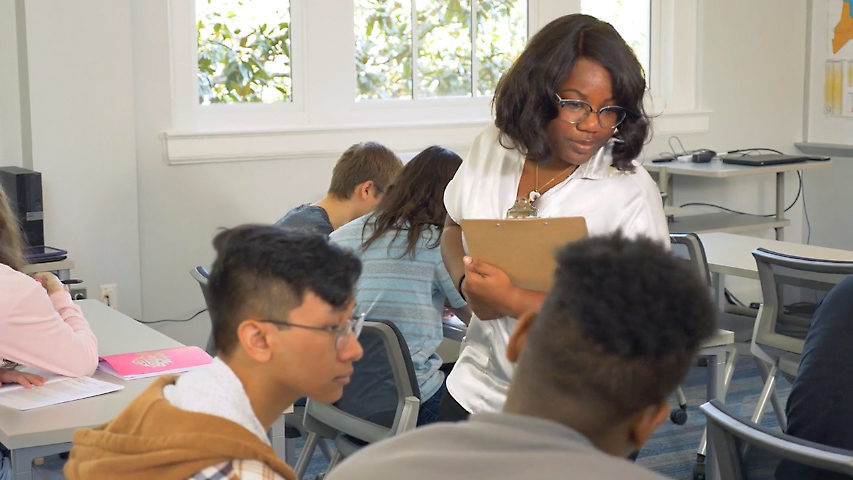What strategies can educators implement to prevent or address challenging behaviors?
Page 4: Active Supervision
 Active supervision requires the educator to frequently and intentionally:
Active supervision requires the educator to frequently and intentionally:
- Move around the room
- Scan and monitor student behavior
- Interact with students
It is commonly used in both instructional and non-instructional settings (e.g., cafeteria, library, hallways, common areas) to prevent challenging behaviors from occurring (or escalating) while simultaneously encouraging positive and on-task behaviors.
Research Shows
Active supervision is an efficient and effective strategy to reduce challenging behaviors and increase positive ones:
- In classroom and non-classroom settings
- During transitions to different activities or settings
- Across age groups
(Allen, Common, Germer, Lane, Buckman, Oakes, & Menzies, 2020; Gage, Haydon, MacSuga-Gage, Flowers, & Erdy, 2020; Haydon, DeGreg, Maheady, & Hunter, 2012; van der Mars, Volger, Darst, & Cusimano, 1994)
Using the Strategy
To help educators prevent or address challenging behavior, the table below describes the steps to implement active supervision and provides an example.
| Steps | Description | Example |
|
To prevent challenging behavior from occurring, identify when or where students are commonly off-task or likely to engage in challenging behaviors. |
The teacher identifies the context in which challenging behavior occurs. Context: Small-group science labs. Challenging Behavior: A few students engage in off-topic conversation during their science lab experiments. |
|
Remind students of the behavior expectations before they get started. |
The teacher reminds the students of the classroom expectation to keep conversation related to the science lab experiment. |
|
Once students begin the activity, walk around the room, frequently and intentionally scanning the room and monitoring student behavior. Be sure to circulate throughout the entire classroom, making sure you vary pathways. |
The teacher walks around the classroom observing students as they work. He increases the frequency with which he scans and monitors groups who tend to engage in off-topic conversation. |
|
Walk around the room and interact with students: Reinforce desired behaviors: Use non-verbal (e.g., eye contact, thumbs up) as well as verbal cues (e.g., behavior-specific praise) to indicate to students that they are following expectations. Address challenging behaviors: Redirect behavior quickly, calmly, respectfully, and in a neutral tone. As soon as students get back on track and begin to follow expectations, acknowledge their behavior and offer positive reinforcement. |
The teacher offers behavior-specific praise to students who remain on-task. When he hears a group begin to talk about their weekend plans, he quickly redirects them with a question about the experiment. He offers behavior-specific praise once they return to talking about the science experiment and working collaboratively. |
In this video, Ms. Harris engages in active supervision as students work with a partner (time: 1:07).
Transcript: Active supervision
Narrator: Active Supervision—Note how the teacher provides a prompt, scans and monitors while walking around the room, and interacts with students.
Teacher: Okay. Today we are going to read an informational text. Before we read the text, I want you all to make predictions about the central idea. Take about 30 seconds and turn and talk with your partner about your predictions.
[Students discuss their predictions about the text with their partners.]
[Teacher scans and monitors while walking around the room.]
Teacher: Great predictions, guys! I’m hearing a lot of good predictions.
[Teacher continues to scan and monitor while walking around the room.]
Teacher: Alrighty. Let’s bring it back to the front in five, four, three, two, one. Let’s hear some predictions!
In addition to the four steps listed above, the three actions below can be helpful when implementing this practice.
Students may not be aware of the behavioral expectations for a particular activity or setting. For example, some students may need to be given explicit directions on how to ask for help if they have a question or feel that the activity is too difficult. Other students may need more help or reminders to understand what’s expected during transitions, including what to do if they have not finished one activity before it is time to move on to the next.
Walking around the classroom facilitates close physical proximity (e.g., within three feet) to all students, which can prevent challenging behavior and increase student engagement (i.e., proximity control). To do so easily, arrange your classroom in ways that allow you to quickly and efficiently scan, monitor, and physically access all areas.
Keep in mind that even in large open spaces, like cafeterias and common areas, you still need to actively walk around and maintain an appropriate level of proximity to interact with students and prevent challenging behaviors from occurring.
Check in with students to see if they find your prompts or reinforcement helpful. For example, it may be that they prefer verbal reinforcement rather than non-verbal reinforcement. Active supervision may also be new or unfamiliar to students, and they may find your constant monitoring to be intrusive. Remind students that you do this to support them and help them succeed.
In this interview, Janel Brown explains why it’s important to use active supervision (time: 2:22).

Transcript: Janel Brown
Active supervision… It’s not standing at the desk lecturing. It is literally walking the aisles of the classroom. You catch those off-task behaviors more quickly if you’re up and walking. If your kids are in groups having discussions, you’re listening to what’s being discussed. If you find students who are disagreeing on what needs to be done, you stop and you have a quick 30-second conversation. This is what you’re supposed to be doing. You just try to redirect the conversation so the kids are on track to get what needs to be done done. Walking, scanning, monitoring does away with the off-task behavior because they see that you’re watching them, and you can hear what they’re saying. And if the kids aren’t saying something that’s correct, you stop in that moment and you correct the problem. You make eye contact with the group, a simple nod of the head, a simple thumbs up to let them know that they are on the right track and they’re doing exactly what they’re supposed to be doing. “Group A, I love how you guys are taking your job seriously and that you’re talking collaboratively within your group to come up with a solution to this problem.” Or “I love how you guys are working together to solve this math problem. That’s what partners do. You work together.” You give specific praise in that instance. So, if Group A is doing that, and you’ve given them that praise, then guess what? Group B, C and D, they’re going to start doing the same thing because they just got praised. So that’s going to bring the behaviors of all the other groups the same. And guess what? You give them praise as well. “Oh, Group D, awesome work. I love how you’re working together collaboratively. You’re not arguing, and you guys are sharing your opinions and everybody’s contributing to the discussion.” So you give that specific praise to everyone if they’re on the right track.
Tier 2 Support
Although active supervision can be used as a Tier 1 strategy, it can also be used as a Tier 2 support for students with moderate levels of externalizing or internalizing behaviors. The steps are the same as when used as a Tier 1 support, but for Tier 2 the educator engages in active supervision with greater intensity (e.g., monitors and interacts with students more often). To determine if the strategy is effective, the educator collects and analyzes the data using the following steps:
- Identify the student behavior to be addressed (e.g., students scrolling social media on their phones) during an instructional period in which the behavior typically occurs (e.g., science, math).
- Collect baseline data on the student behavior for a designated timeframe (e.g., first 20 minutes of class) during the identified instructional period. Collect this data across several days (e.g., 3 to 5 days) to see how often this behavior occurs or how long each episode lasts.
- Implement or intensify active supervision and continue to collect data (e.g., same instructional period, same length of time) for 3 to 5 days to determine whether the student’s behavior changes.
- Evaluate the effect of active supervision. Compare the implementation data to the baseline data to evaluate whether the strategy has had the desired effect on the student’s behavior.

To make sure you are using this strategy with fidelity, download this active supervision implementation checklist. To view our IRIS Fundamental Skill Sheet on active supervision, click the title below. To view our IRIS Fundamental Skill Sheet on proximity control, click the title below. To learn more about effectively arranging your classroom, click the IRIS Case Study title below. |